Cleptomita was a genus of moths of the family Noctuidae first described by Augustus Radcliffe Grote in 1873.

Zanclognatha is a genus of litter moths of the family Erebidae. The genus was erected by Julius Lederer in 1857.
Megachyta was a genus of moths of the family Noctuidae first described by Augustus Radcliffe Grote in 1873.
Pityolita was a genus of moths of the family Erebidae first described by Augustus Radcliffe Grote in 1873.
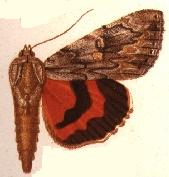
Catocala coccinata, the scarlet underwing, is a moth of the family Erebidae. The species was first described by Augustus Radcliffe Grote in 1872. It is found in southern Canada and the eastern United States, following river valleys onto the Great Plains and down to Florida.
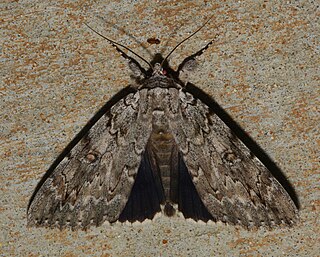
Catocala robinsonii, or Robinson's underwing, is a moth of the family Erebidae. The species was first described by Augustus Radcliffe Grote in 1872. It is found in North America from southern Ontario and New Hampshire south to Florida west to Oklahoma, Missouri and Arkansas and northward to Illinois, Indiana, and Michigan.
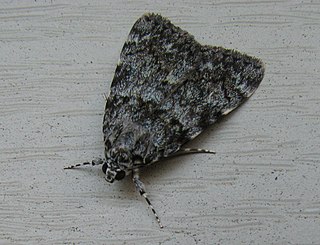
Catocala lineella, the lineella underwing, little lined underwing or steely underwing, is a moth of the family Erebidae. The species was first described by Augustus Radcliffe Grote in 1872. It is found in North America from Ontario and Quebec south to Florida west to Texas and north to Ohio.
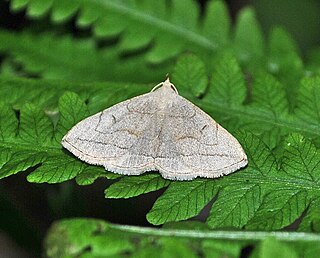
Zanclognatha pedipilalis, the grayish zanclognatha, is a litter moth of the family Erebidae. The species was first described by Achille Guenée in 1854. It is found in eastern North America, from Nova Scotia south to Florida and Mississippi, west to Alberta and Kansas.
Zanclognatha atrilineella is a litter moth of the family Erebidae. It was described by Augustus Radcliffe Grote in 1873. It is found in the southeastern United States.
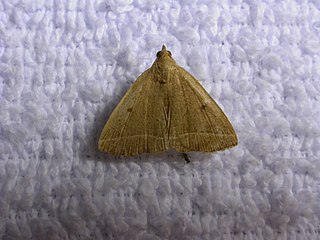
Zanclognatha marcidilinea, the yellowish zanclognatha, is a litter moth of the family Erebidae. It was described by Francis Walker in 1859. It is found in North America from Nova Scotia to Missouri, south to Florida and Arkansas.

Zanclognatha laevigata, the variable zanclognatha, is a litter moth of the family Erebidae. It was described by Augustus Radcliffe Grote in 1872. It is found in North America from Manitoba to Nova Scotia, south to Florida and Missouri.

Zanclognatha lituralis, the lettered zanclognatha, is a litter moth of the family Erebidae. It was described by Jacob Hübner in 1818. It is found from in North America from Wisconsin to Nova Scotia, and south to Florida and Texas.

Isogona tenuis, the thin-lined owlet, is a moth of the family Erebidae. The species was first described by Augustus Radcliffe Grote in 1872. It is found from Ontario, Wisconsin, Ohio and New Jersey, south to Florida and Texas.
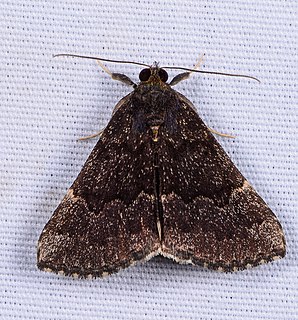
Hypena sordidula, the sordid hypena or sordid bomolocha moth, is a moth of the family Erebidae. The species was first described by Augustus Radcliffe Grote in 1872. It is found in North America from Quebec and Maine south to northern Florida and Texas, west to Louisiana and Kansas, north to Manitoba.

Colobochyla interpuncta, the swamp belle or yellow-lined owlet, is a moth of the family Erebidae. The species was first described by Augustus Radcliffe Grote in 1872. It is found in North American wetlands from Wisconsin to Nova Scotia south to Florida and Texas.
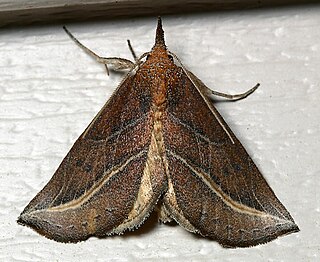
Phyprosopus callitrichoides, the curve-lined owlet, is a moth of the family Erebidae. The species was first described by Augustus Radcliffe Grote in 1872. It is found in the US from New Hampshire to Florida, west to Montana and Texas.

Cirrhophanus triangulifer, the goldenrod stowaway or tickseed moth, is a moth of the family Noctuidae. The species was first described by Augustus Radcliffe Grote in 1872. It is found in the US from New York to Florida, west to Texas and Oklahoma, north to Wisconsin. In Canada, it has only been recorded from Ontario.

Deltote musta, the small mossy lithacodia moth, is a moth of the family Noctuidae. The species was first described by Augustus Radcliffe Grote and Coleman Townsend Robinson in 1868. It is found in the US from New Hampshire to Florida, west to Arizona and north to Wisconsin.

Acrolophus mortipennella is a moth of the family Acrolophidae. It was described by Augustus Radcliffe Grote in 1872. It is found in North America, including Alabama, Florida, Illinois, Kentucky, Louisiana, Mississippi, Ohio, South Carolina and Texas.

Diacme adipaloides, the darker diacme moth, is a moth in the family Crambidae. It was described by Augustus Radcliffe Grote and Coleman Townsend Robinson in 1867. It is found in North America, where it has been recorded from Alabama, Arkansas, Florida, Indiana, Maine, Maryland, Massachusetts, Michigan, Minnesota, New Brunswick, New Hampshire, New Jersey, New York, North Carolina, Nova Scotia, Ohio, Oklahoma, Ontario, Quebec, South Carolina, Tennessee, Texas, Virginia, West Virginia and Wisconsin.















